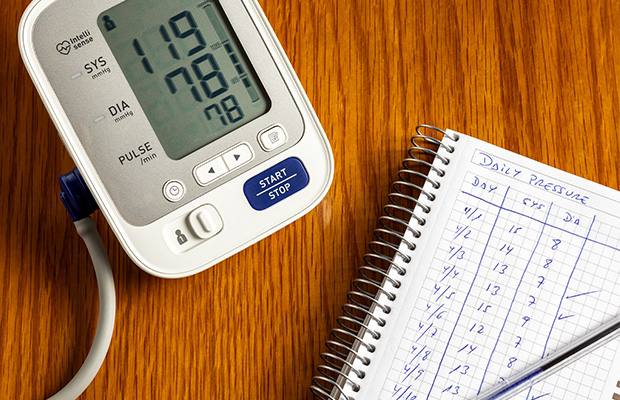High blood pressure (hypertension) often has no symptoms but it can increase the risk of heart attack and stroke. That’s why it’s important to have it regularly checked.
This is done using an inflatable cuff that goes around the upper arm and records your blood pressure on a monitor as it deflates.
Many people have their blood pressure checked at their GP surgery or in hospital to see if it’s high, which is when the top reading on the monitor (systolic blood pressure) is over 140mmHg, and the bottom reading (diastolic blood pressure) is over 90mmHg, according to UK guidance.
However, UK media outlets warned in October that if the test is done incorrectly it can result in falsely high readings, which may lead to people who do not have high blood pressure being diagnosed with it and unnecessarily treated.
They were reporting on new research that found people’s blood pressure readings were higher when their arm hung by their side or rested on their lap, compared to when their arm rested on a table at the same level as their heart, which is how clinical guidelines recommend readings are taken.
For example, The British and Irish Hypertension Society (BIHS) says your arm “should be supported at the level of the heart" when having your blood pressure taken, and the UK’s National Institute for Health and Care Excellence (NICE) says it should be “outstretched and supported”.
And in the United States, where the study was carried out, the Centers for Disease Control and Prevention (CDC) recommends measuring blood pressure while “the arm is resting on a table at chest height”.
But the researchers wrote in the journal JAMA Internal Medicine that people’s blood pressure is still commonly taken while their arm is by their side or on their lap, which could affect the results.
Want to get fit and healthy?
Sign up to our fortnightly Heart Matters newsletter to receive healthy recipes, new activity ideas, and expert tips for managing your health. Joining is free and takes 2 minutes.
I’d like to sign-up
To test this, they measured the blood pressure of 133 people who were aged 57 on average. They measured it in 3 different arm positions – resting on a desk at heart level, on their lap and hanging by their side – and then worked out the average reading for each.
Overall, they found systolic blood pressure was 6.5mmHg higher and diastolic blood pressure 4.4mmHg higher when the arm hung by the person’s side compared to when it rested on a desk.
The readings were higher when people had their arms in their lap too. Systolic blood pressure was 3.9mmHg higher and diastolic blood pressure 4mmHg higher than when their arm was on a desk.
This difference was even higher in those who already had high blood pressure, which the researchers classed as an average systolic blood pressure of above 130mmHg. In these people, systolic blood pressure readings were 8.5mmHg higher when their arm was by their side than when it rested on a desk.
The researchers from John Hopkins Medicine suggested that the higher readings were caused by these arm positions creating a larger distance between the arm and the heart, which may increase blood pressure in the arm.
They also said that blood pressure may be higher when people’s arm hung unsupported by their side, as this could have led to their muscles contracting, which can temporarily raise blood pressure.

What do the researchers say?
The researchers say their results reinforce current guidelines on how to take blood pressure, as they show using the wrong arm position can lead to a false diagnosis of high blood pressure.
The researchers estimated that, if the wrong arm position was always used, 16 per cent of United States’ adults, equal to 40 million people, would be wrongly diagnosed with high blood pressure based on data from the CDC's National Health and Nutrition Examination Survey.
This could lead to people being treated for high blood pressure when they did not need to be, they warned.
How good was the research?
While the research shows how important it is to measure blood pressure in the recommended way, it did not say how often healthcare professionals use the wrong arm position. The study only stated that “proper arm position is commonly overlooked”.
The study was also small, including only 133 people aged between 18 and 80, with 70 (53 per cent) women and 103 (77 per cent) Black people – and so the results could be different for other groups of people.
A key strength of the study is that the researchers tried to create similar conditions to the ones people normally experience when having their blood pressure measured in a hospital or clinic.
For each arm position, all participants walked for 2 minutes, sat and rested for 5 minutes, before getting their blood pressure measured 3 times with 30 seconds between each measurement.
How good was the media coverage?
Lots of UK media outlets reported on the study, including The Times, The Telegraph, Daily Mail, Daily Mirror and The Independent.
While most of these newspapers’ coverage of the study and its findings was fairly accurate, none explained that the desk people in the study rested their arm on was at the same level as their heart.
This is an important missing detail, as the researchers suggest the difference in blood pressure readings when a person’s arm was on their lap, or by their side, was partly caused by their arm being lower and further from their heart.
Therefore, resting your arm on a low table, below your heart, could still lead to falsely high readings.
The BHF verdict
"This study reinforces why guidelines are very specific about how to measure blood pressure to ensure readings are accurate,” said Professor Bryan Williams, Chief Scientific and Medical Officer at British Heart Foundation, in response to the Daily Mail’s article.
“Measuring blood pressure is one of the simplest ways to identify people at risk of heart disease and stroke, but it is important that the measurement is done properly if it is to be used to guide treatment decisions."
If you’re measuring your blood pressure yourself at home, make sure to follow clinical guidelines and sit in the recommended position for the most accurate results.
This means sitting upright with your back against the back of a chair and feet flat on the floor, with your arm resting on a table at the same height as your heart.
What to read next...










